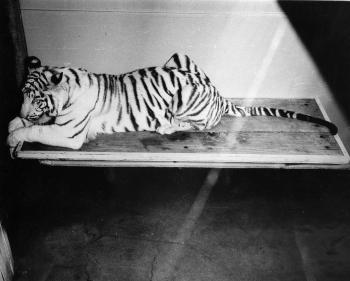As an intern in the Institutional History Division of the Smithsonian Institution Archives, I have had the pleasure of listening to the oral history interviews of Dr. Theodore Reed, Smithsonian National Zoological Park director from 1958-1984. Just like at the Smithsonian Museums, the National Zoo has always prided itself in its collections, particularly since the direction of Dr. Reed began.
Dr. Reed was a veterinarian first, a forerunner in the field, and procurer of some of the most unique animals from around the world, including endangered species. But these animals weren’t just for show. In 1975 Dr. Reed created the Conservation and Research Center (now Smithsonian Conservation Biology Institute), a facility designed to study, breed and protect endangered animals, some of which hopefully will be released back in to the wild.

Some rare animals have lived at the National Zoo including giant pandas, black footed ferrets, clouded leopards, golden lion tamarins, Bactrian camels, and maned wolves. But one of the rarest animals ever to join the National Zoo collection was the white tiger. During a 1989 interview, Dr. Reed discussed the somewhat difficult procurement of the first white tiger in America. This magnificent animal was aptly named Mohini after the only female embodiment of the Hindu God Vishnu. Goddess Mohini was known to be an enchantress and sometimes even femme fatale. Mohini was among the first litter of white tigers in the world ever to be born in captivity. In 1960, Dr. Reed purchased Mohini in India for the sum of $10,000. Today, that would be around $80,000.

Contrary to popular belief, white tigers are not albino. Their very rare white fur color occurs when both parents contain a recessive gene that controls fur pigment (or the lack thereof). White tiger cubs can be born from two orange parents, one white and one orange parent, or two white parents. Because obtaining tigers with this recessive gene has proven to be so expensive and difficult, most of the captive white tigers in America today are direct descendants of Mohini. Mohini had only one white cub who survived, a male named Moni. But her orange cubs would have also possessed the white pigment gene, so they were bred to other tigers in hopes of producing white tiger offspring.

Eventually, the inbreeding of white tigers became problematic. Many of them had severe defects including shortened legs, kidney problems, crossed eyes, and psychological issues. Most white tigers didn’t survive past infancy. When the last white tiger at the National Zoo Panghur Ban (great grandson of Mohini) died in 2002, the National Zoo ceased the collection of white tigers.

Several zoos around the country continue to keep and breed white tigers in captivity, but due to ethical standards, the National Zoo will no longer do so. Current curator of Great Cats at the National Zoo Craig Saffoe explains, “We no longer house, manage or breed white tigers because it is not responsible (in terms of conservation) to do so.” Saffoe went on to say that the white fur gene might actually need to be bred out of tigers as it does not help them evolutionarily. White tigers are easily spotted by predators in the wild. In addition, white tigers tend to have genetic defects and die young, even if they are not inbred. While visitors to the National Zoo are no longer able to view white tigers, they can take pride in the fact that the Zoo strives to adhere to the highest ethical standards of animal care and will continue to keep the best interests of the animals and their conservation at the forefront of its work.
Related Resources
- Historic Images of the National Zoo, Smithsonian Institution Archives
- History of the National Zoo, Smithsonian Institution Archives
Related Collections
- Record Unit 9568 - Oral history interviews with Theodore H. Reed 1989-1994, Smithsonian Institution Archives
Produced by the Smithsonian Institution Archives. For copyright questions, please see the Terms of Use.


Leave a Comment